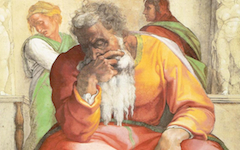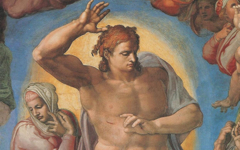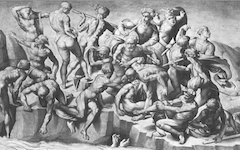Michelangelo’s Florentine Pieta (1547-53)
Michelangelo's last Pieta, left unfinished at his death but intended for his tomb, helps us make sense of his more famous version carved when he was young.

Michelangelo, Florentine Pietá (c.1547-53) Marble. Museo dell'Opera del Duomo, Florence.
Click image to enlarge.
A Pieta traditionally depicts the seated Virgin grieving over her son's lifeless body. Here, though, Michelangelo added a third, much larger figure standing behind Christ and the Virgin. It is Nicodemus, a sculptor whom medieval legend claimed was present at the Entombment and whom Michelangelo here gave his own features. (The figure on the far left was added after Michelangelo died.) By placing his self-portrait behind Christ and his mother, and on a much larger scale, Michelangelo suggests that he, Nicodemus/Michelangelo, has carved the scene and presents it to us for our admiration. He is on a different level of reality than Christ and the Virgin. They are "a marble sculpture"; he is real.
The above interpretation is the only one that explains why the figure of Nicodemus is so much larger than the other two. Now turn to the article on Michelangelo’s Vatican Pieta to make sense of that work's visual inconsistencies as well.
See also how Rembrandt did something similar in Self-Portrait with a Dead Bittern.
More Works by Michelangelo
There's probably more unseen in Michelangelo's Sistine Chapel than has ever been known....

Michelangelo’s Sistine Ceiling: Jeremiah (c.1509-10)
Notes:
Original Publication Date on EPPH: 11 May 2010. | Updated: 0. © Simon Abrahams. Articles on this site are the copyright of Simon Abrahams. To use copyrighted material in print or other media for purposes beyond 'fair use', you must obtain permission from the copyright owner. Websites may link to this page without permission (please do) but may not reproduce the material on their own site without crediting Simon Abrahams and EPPH.


